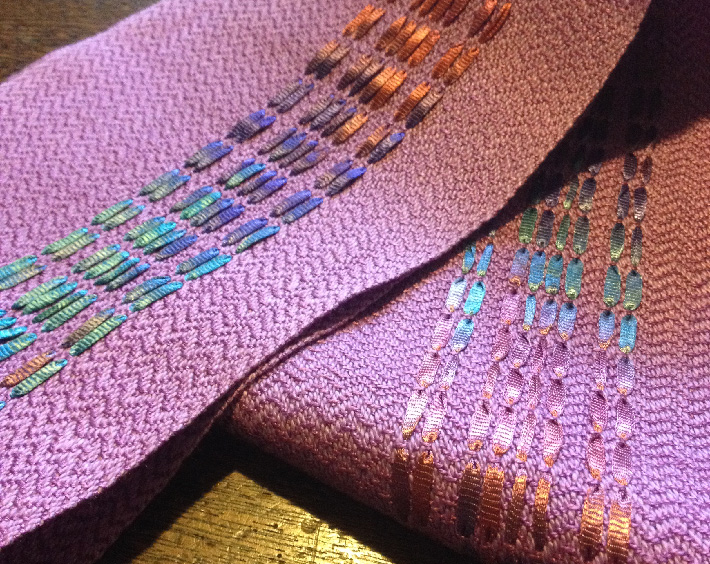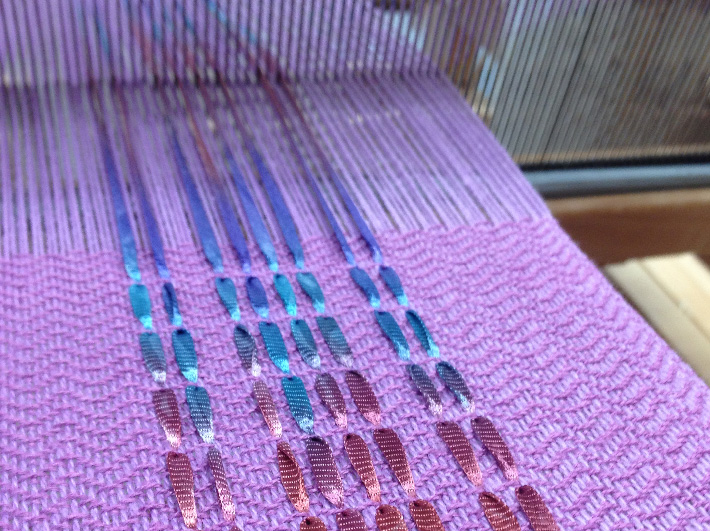A visitor to my studio was recently captivated by a skein of thick silk hanging on a peg on my “yarn wall.” She wondered what could a weaver do with such a luscious yarn. It seems a shame to bury it in a weave structure where its quirky colors and textures won’t be seen.

One of my favorite methods for using unusual fibers in weaving is to add them as a supplementary warp and weave them so that they seem to sit on top of the cloth, maximizing the amount you can see in the finished piece. The beauty of this approach is that it is very easy to accomplish!
Yarn choices
Your ground warp — that is, the warp that will form the body of the cloth you are weaving — can be any color or fiber you like, but it should complement your fancy yarn without overpowering it.
I decided to illustrate this process by using a multi-colored ribbon as my featured yarn. I wanted it to lie flat against the finished piece, so I have used a lilac cotton as the ground warp and a similar shade in silk for my weft. I know these yarns will not shrink very much in the wet finishing. If I was looking for a more textured finish I might choose a wool yarn for my ground warp to introduce some differential shrinkage.
Handling
Some weavers prefer to wind the whole warp together. Personally, I find it easier to handle fancy yarns separately, so I wind and beam the ground warp first. Then I wind my supplementary warp bouts individually.


In this case, I just created one additional warp bout with eight ends of ribbon to make a patterned stripe. I followed this technique for keeping the colors on a symmetrically dyed yarn together. I put the ribbon onto a second pair of lease sticks, with a choke tie just behind the cross to keep the yarn from slipping during threading and sleying.
Once it was time to weave, I weighted the supplementary ends with an S-hook and washers. It’s a good idea to have plenty of choke ties along the length of this warp bout to help keep everything in order.
Drafting
You can use any structure you like for the ground cloth as long as you have at least one shaft left over for your supplementary ends. I chose to use a point twill threading on four shafts and thread my ribbon alternately on shafts 5 and 6. Using two shafts — rather than one — for your supplementary ends lets you choose between stitching them into the ground cloth either at the same point or at different points. The draft I used (and some alternatives on four shafts) are available here.
How far apart you space your supplementary ends will depend on several things, including:
- The thickness of your fancy yarn compared with your ground warp
- Whether you want to see the ground cloth in between the supplementary ends
- How you want to work the extra shafts into the pattern
I chose to add one ribbon after every four cotton ends in the pattern area, leaving a gap of eight ends where I wanted to create a larger space.
Other practicalities
You can sley your fancy yarn on top of your ground cloth so that the basic sett remains unchanged, or you can leave it a little more space if you prefer. It’s worth sampling with your yarn to see which you prefer. For my multi-colored ribbon, I chose to sley on top. This means it is quite a tight fit when the ribbon passes through to the back of the cloth, but I like the tapered shape this creates.
Most of the time while you are weaving, you will keep the shafts for the fancy yarn raised, only lowering them for the occasional stitch into the cloth. Don’t forget they are there!
You can have a lot of fun trying this out with different types of yarn. Thick slubby yarns work well, as do yarns with inclusions and finer yarns grouped together in a bundle.


Share tips, start a discussion or ask one of our experts or other students a question.
No Responses to “The Simple Method for Weaving Yarns That Deserve the Spotlight”